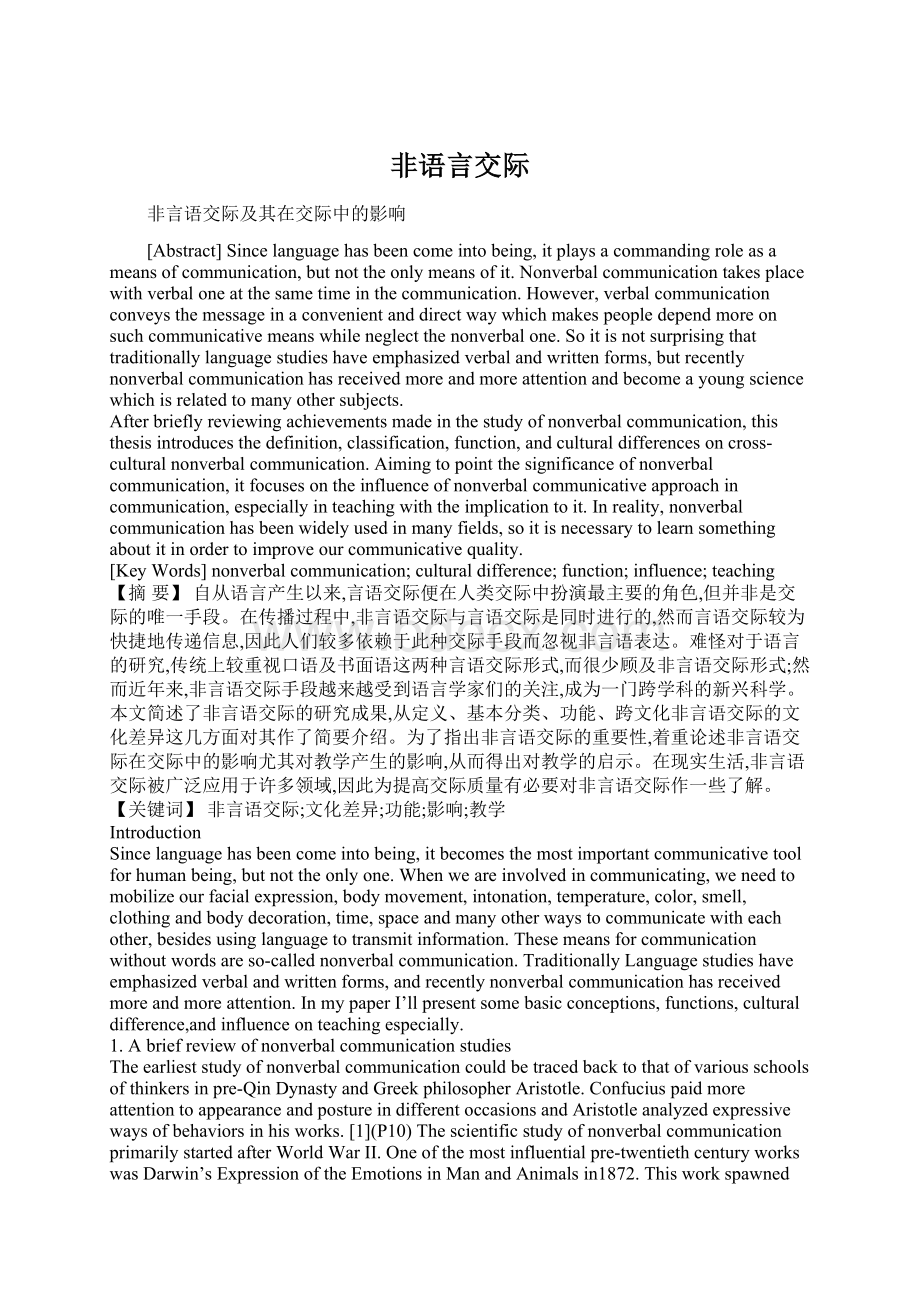非语言交际.docx
《非语言交际.docx》由会员分享,可在线阅读,更多相关《非语言交际.docx(11页珍藏版)》请在冰豆网上搜索。

非语言交际
非言语交际及其在交际中的影响
[Abstract]Sincelanguagehasbeencomeintobeing,itplaysacommandingroleasameansofcommunication,butnottheonlymeansofit.Nonverbalcommunicationtakesplacewithverbaloneatthesametimeinthecommunication.However,verbalcommunicationconveysthemessageinaconvenientanddirectwaywhichmakespeopledependmoreonsuchcommunicativemeanswhileneglectthenonverbalone.Soitisnotsurprisingthattraditionallylanguagestudieshaveemphasizedverbalandwrittenforms,butrecentlynonverbalcommunicationhasreceivedmoreandmoreattentionandbecomeayoungsciencewhichisrelatedtomanyothersubjects.
Afterbrieflyreviewingachievementsmadeinthestudyofnonverbalcommunication,thisthesisintroducesthedefinition,classification,function,andculturaldifferencesoncross-culturalnonverbalcommunication.Aimingtopointthesignificanceofnonverbalcommunication,itfocusesontheinfluenceofnonverbalcommunicativeapproachincommunication,especiallyinteachingwiththeimplicationtoit.Inreality,nonverbalcommunicationhasbeenwidelyusedinmanyfields,soitisnecessarytolearnsomethingaboutitinordertoimproveourcommunicativequality.
[KeyWords]nonverbalcommunication;culturaldifference;function;influence;teaching
【摘要】自从语言产生以来,言语交际便在人类交际中扮演最主要的角色,但并非是交际的唯一手段。
在传播过程中,非言语交际与言语交际是同时进行的,然而言语交际较为快捷地传递信息,因此人们较多依赖于此种交际手段而忽视非言语表达。
难怪对于语言的研究,传统上较重视口语及书面语这两种言语交际形式,而很少顾及非言语交际形式;然而近年来,非言语交际手段越来越受到语言学家们的关注,成为一门跨学科的新兴科学。
本文简述了非言语交际的研究成果,从定义、基本分类、功能、跨文化非言语交际的文化差异这几方面对其作了简要介绍。
为了指出非言语交际的重要性,着重论述非言语交际在交际中的影响尤其对教学产生的影响,从而得出对教学的启示。
在现实生活,非言语交际被广泛应用于许多领域,因此为提高交际质量有必要对非言语交际作一些了解。
【关键词】非言语交际;文化差异;功能;影响;教学
Introduction
Sincelanguagehasbeencomeintobeing,itbecomesthemostimportantcommunicativetoolforhumanbeing,butnottheonlyone.Whenweareinvolvedincommunicating,weneedtomobilizeourfacialexpression,bodymovement,intonation,temperature,color,smell,clothingandbodydecoration,time,spaceandmanyotherwaystocommunicatewitheachother,besidesusinglanguagetotransmitinformation.Thesemeansforcommunicationwithoutwordsareso-callednonverbalcommunication.TraditionallyLanguagestudieshaveemphasizedverbalandwrittenforms,andrecentlynonverbalcommunicationhasreceivedmoreandmoreattention.InmypaperI’llpresentsomebasicconceptions,functions,culturaldifference,andinfluenceonteachingespecially.
1.Abriefreviewofnonverbalcommunicationstudies
Theearlieststudyofnonverbalcommunicationcouldbetracedbacktothatofvariousschoolsofthinkersinpre-QinDynastyandGreekphilosopherAristotle.ConfuciuspaidmoreattentiontoappearanceandpostureindifferentoccasionsandAristotleanalyzedexpressivewaysofbehaviorsinhisworks.[1](P10)ThescientificstudyofnonverbalcommunicationprimarilystartedafterWorldWarII.Oneofthemostinfluentialpre-twentiethcenturyworkswasDarwin’sExpressionoftheEmotionsinManandAnimalsin1872.Thisworkspawnedthemodernstudyoffacialexpression,andmanyofhisobservationsandideashavebeenvalidatedbyotherresearchers.Inthefirsthalfofthetwentiethcentury,thestudyofnonverbalcommunicationstillremainedunsystematicfortherewereonlyisolatedstudiesofvoice,physicalappearance,dressandfacialexpressions.ThethreeinfluentialworksduringthisperiodwereKretschmer’sbookPhysiqueandCharacterin1925,Sheldon’sbookTheVariationsofHumanPhysiquein1940,andEfron’sbookGestureandEnvironmentin1941.In1950s,therewasasignificantincreaseinthenumberofnonverbalresearchefforts.Birdwhistell’sIntroductiontoKinesicsin1952andHall’sSilentLanguagein1959weretwomilestonesofthisdecade.In1956,RueschandKeesproducedabookentitledNonverbalCommunication:
NotesontheVisualPerceptionofHumanRelations.Thiswasthefirstbooktousethetermnonverbalcommunicationinitstitle.1960sproduceda“nuclearexplosion”ofnonverbalstudies.Duringthistime,theclassictheoreticalpiecewasEkman’sandFriesen’sarticleontheorigins,usage,andcodingofnonverbalbehavior.The1970sprovedtobeatimeofsummarizingandsynthesizingonnonverbalstudies.ItbeganwithJuliusFast’sBodyLanguagein1970.Thisbookwasthebest-sellingvolumeatthattimeandithasnowbeentranslatedintoseveralChineseversions.The1980swereatimeoffurtherdevelopmentofnonverbalcommunicationstudies.Somenonverbalresearchesofthisdecadefocusedonidentifyingthewaysavarietyofnonverbalsignalsworktogethertoaccomplishcommoncommunicativegoals.Theresearchonnonverbalbehaviorinourcountrybeganfrom1980s.ScholarssuchasHuWenzhong,BiJiwan,DengYianchangandLiuRunqinghavedonesomeresearchwork.[2](P40-41)
Whywebegantheresearchonnonverbalcommunicationlaterthanwesterncountries,sofarasIknow,there’resomereasonsforit.SinceJosephStalinhadcriticizedthe“gesture”ofMarin1950,thescholarsinourcountrywhostudiedlinguistictheoryconsidereditasguidingprincipletoconfirmthefunctionoflanguagecommunicationabsolutelywithoutconsideringthepositionandfunctionofnonverbalcommunicationincommunication.Asaresult,therangeofstudyisonlylimitedtolanguageandcommunicativetoolbasedonlanguage.[1](P1)Andduring1960s-1970sCulturalRevolutionhappenedinourcountrybringingadisastertothestudyofthisfield.
2.Definitionandclassificationofnonverbalcommunication
Therearevariousdefinitionsfornonverbalcommunicationamongdifferentscholars.AccordingtoKnapp[2](P41)thephrasenonverbalcommunicationreferstocommunicationeffectbymeansotherthanwords(assumingwordsaretheverbalelement).Whendefiningnonverbalcommunication,SamovarandPorterproposethat“nonverbalcommunicationinvolvesallthosenonverbalstimuliinacommunicationsettingthataregeneratedbyboththesourceandhisorheruseoftheenvironmentandthathavepotentialmessagevalueforthesourceorreceiver”.Inthisdefinition,theroleoftheenvironment,themessagevalueofnonverbalstimuliandthecommunicationsettingareemphasizedasthreeimportantfactorsinnonverbalcommunication.[2](P41)Inshort,nonverbalmeansforcommunication,whichisconsideredas“silentlanguage”,expressesmeaningsorfeelingswithoutusingwords.
Asdifferentlinguistsdescribenonverbalcommunicationindifferentdimensions,thereisnogeneralagreementinclassificationasyet.Hereweonlyproposesomeofthecommontopicsmostcommunicationtheoristsaddressthemselvesto:
“Nonverbalcommunicationconsistsofallsignalingsystemsthatdonotusewords.”[3](P181)
1)bodymodesofnonverbalcommunication(kinesics):
posture,gestures,eyecontact,facialexpressions,appearance,smell,shiftsinskincolor,usesofclothingandbodydecoration,bodyorientation,anyothermovementofanyotherpartofthebody;
2)spacelanguage(bodydistanceorproxemics):
bodytouchandbodydistance;
3)paralanguage(voicemodulation):
speed,pitch,volume,pause,intonation,etc;
4)timelanguage:
timeorientation(past,present,andfuture),monochromic(M-time)andpolychromic(P-time);
5)environmentalcommunication(interrelationshipbetweenpeopleandtheirenvironments):
architecture,object,color,lighting,odorsetc;
6)communicationofgeneticcharacteristics,whichareconsideredbysomescholarsasnonverbalcommunication;
7)variousartformsandmediasuchaspainting,architecture,music,film,ballet,andmime
3.Functionsofnonverbalbehaviorincommunication
Insometypesofcommunicationpeopleexpressmorenonverballythanverbally.“OnestudydoneintheUnitedStatesshowedthatinthecommunicationofattitudes,93%ofthemessagewastransmittedbythetoneofthevoiceandbyfacialexpressions,whereasonly7%ofthespeaker’sattitudewastransmittedbywords.”[4](P122)Nonverbalcommunicationissignificantinhumaninteractionbecauseitisusuallyresponsibleforfirstimpression.Thinkforamomentforhowoftenyourfirstjudgmentsarebasedonthecolorofaperson’sskinorthemannerinwhichheorsheisdressed.Moreimportant,thoseinitialmessagesusuallyinfluencetheperceptionofeverythingelsethatfollows.
Nonverbalbehaviorsandverbalcommunicationinteractincommunicationprocess.Forsimplicity,nonverbalcommunicationservestorepeat,complement,reinforce,substitute,regulateorevencontradictourverbalbehavior.[4](P137-139)
3.1Repeating
Nonverbalcommunicationcansimplyrepeatwhatwassaidverbally.Forinstance,verbalstatementsofagreementordisagreementareoftenaccompaniedbyanodorshakeoftheheadtoconveypositiveornegativefeelings.Wemightholdupourhandinthegesturethatsignifiesapersontostopatthesametimeweactuallyusetheword“stop”.Orwemightpointinacertaindirectionafterwehavejustsaid(whentellapersonthewaytotherailwaystation,yougenerallyaddalittleinformationbypointingintheproperdirection.).Thesecouldbeconsideredrepetitionbecausetheyindicatethesamemeaningastheverbalmessages.
3.2Complementing
Closelyrelatedtorepeatingiscomplementing.Althoughmessagesthatrepeatcanstandalone,complementinggenerallyaddsmoreinformationtomessages.Nonverbalsignalscanmodifyorelaborateonverbalmessages.Theactorsoractressesofcomedyorskitorshortcrosstalkaregoodatperformingbodylanguagetomaketheirperformancelivelyandmoreeasilyattracttheattentionofaudiences.Ifyoutellyourfriendthatyouhavenomoneytolendhim,youmayturnoutyourpocketstoshowyoursincereregret.Youcantellsomeonethatyouarepleasedwithhisorherperformance,butthismessagetakesonextrameaningifyoupatth